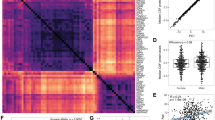Abstract
Studies have identified structural abnormalities in areas of the autistic brain, with a pattern suggesting that a neurodevelopmental anomaly took place. Neural cell adhesion molecule (NCAM), which is involved in development of the central nervous system, was previously shown to be decreased in the serum of autistic individuals. In the present study, we measured NCAM protein in the sera from controls, patients with autism, siblings of autistic patients, and individuals with other neurologic disorders, but found no significant differences. We also measured NCAM protein in autistic postmortem brain samples and found the longest isoform, NCAM-180, to be significantly decreased. In addition, we investigated the mRNA expression of NCAM in these brain samples using cDNA microarrays and RT-PCR. Results show that NCAM mRNA levels are not altered in autism.
Similar content being viewed by others
REFERENCES
American Psychiatric Association. (1994). Diagnostic and statistical manual of mental disorders (4th ed.). Washington DC: Author.
Baldwin, T. J., Fazeli, M. S., Doherty, P., & Walsh, F. S. (1996). Elucidation of the molecular actions of NCAM and structurally related cell adhesion molecules. Journal of Cellular Biochemistry, 61, 502-513.
Bradford, M. M. (1976). A rapid and sensitive method for the quantitation of microgram quantities of protein utilizing the principle of protein-dye binding. Analytical Biochemistry, 72, 248-254.
Brummendorf, T., & Rathjen, F. G. (1995). Cell adhesion molecules 1: immunoglobulin superfamily. Protein Profile, 2, 963-979.
Colantuoni, C., Purcell, A. E., Bouton, C. M. L., & Pevsner, J. (2000). High throughput analysis of gene expression in the human brain. Journal of Neuroscience Research, 59, 1-10.
Cunningham, B. A., Hemperly, J. J., Murray, B. A., Prediger, E. A., Brackenbury, R., & Edelman, G. M. (1987). Neural cell adhesion molecule: Structure, immunoglobulin-like domains, cell surface modulation, and alternative RNA splicing. Science, 236, 799-806.
Doherty, P., Fazeli, M. S., & Walsh, F. S. (1995). The neural cell adhesion molecule and synaptic plasticity. Neurobiology, 26, 437-446.
Duggan, D. J., Bittner, M., Chen, Y., Meltzer, P., & Trent, J. M. (1999). Expression profiling using cDNA microarrays. Nature Genetics Supplement, 21, 10-14.
Fields, R. D., & Itoh, K. (1996). Neural cell adhesion molecules in activity-dependent development and synaptic plasticity. Trends in Neuroscience, 19, 473-480.
Harrison, P. J., Heath, P. R., Eastwood, S. L., Burnet, P. W., McDonald, B., & Pearson, R. C. (1995). The relative importance of premortem acidosis and postmortem interval for human brain gene expression studies: Selective mRNA vulnerability and comparison with their encoded proteins. Neuroscience Letters, 200, 151-154.
Jorgensen, O. S. (1995). Neural cell adhesion molecule (NCAM) as a quantitative marker in synaptic remodeling. Neurochemical Research, 20, 533-547.
Kanner, L. (1943). Autistic disturbances of affective contact. Nervous Child, 2, 217-250.
Kemper, T. L., & Bauman, M. (1998). Neuropathology of infantile autism. Journal of Neuropathology and Experimental Neurology, 57, 645-652.
Lord, C., Rutter, M., & Le Couteur, A. (1994). Autism Diagnostic Interview-Revised: A revised version of a diagnostic interview for caregivers of individuals with possible pervasive developmental disorder. Journal of Autism and Developmental Disorders, 24, 659-685.
Luthl, A., Laurent, J. P., Figurov, A., Muller, D., & Schachner, M. (1994). Hippocampal long-term potentiation and neural cell adhesion molecules L1 and NCAM. Nature, 372, 777-779.
Mayford, M., Barzilai, A., Keller, F., Schacher, S., & Kandel, E. R. (1992). Modulation of an NCAM-related adhesion molecule with long-term synaptic plasticity in Aplysia. Science, 256, 638-644.
Minshew, N. J., & Dombrowski, S. M. (1994). In vivo neuroanatomy of autism: Neuroimaging studies. In M. L. Bauman & T. L. Kemper (Eds.), The neurobiology of autism (pp. 66-85). Baltimore: Johns Hopkins University Press.
Nybroe, O., Linnemann, D., & Bock, E. (1989). Heterogeneity of soluble neural cell adhesion molecule. Journal of Neurochemistry, 53, 1372-1378.
Olsen, M., Krog, L., Edvardsen, K., Skovgaard, L. T., & Bock, E. (1993). Intact transmembrane isoforms of the neural cell adhesion molecule are released from the plasma membrane. Biochemical Journal, 295, 833-840.
Piven, J. (1997). The biological basis of autism. Current Opinion in Neurobiology, 7, 708-712.
Plioplys, A. V., Hemmens, S. E., & Regan, C. M. (1990). Expression of a neural cell adhesion molecule serum fragment is depressed in autism. Journal of Neuropsychiatry and Clinical Neuroscience, 2, 413-417.
Raymond, G. V., Bauman, M. L., & Kemper, T. L. (1996). Hippocampus in autism: A golgi analysis. Acta Neuropathologica, 91, 117-119.
Ronn, L. C., Hartz, B. P., & Bock, E. (1998). The neural cell adhesion molecule (NCAM) in development and plasticity of the nervous system. Experimental Gerontology, 33, 853-864.
Rose, S. P. (1995). Cell-adhesion molecules, glucocorticoids and long-term memory formation. Trends in Neuroscience, 18, 502-506.
Rutishauser, U., & Jessel, T. M. (1988). Cell adhesion molecules in vertebrate neural development. Physiology Review, 68, 819-857.
Schopler, E., Reichler, R. J., DeVillis, R. F., & Daly, K. (1980). Toward objective classification of childhood autism: Childhood Autism Rating Scale (CARS). Journal of Autism and Developmental Disorders, 10, 91-103.
Stork, O., Welzl, H., Wotjak, C. T., Hoyer, D., Delling, M., Cremer, H., & Schachner, M. (1999). Anxiety and increased 5-HT(1A) receptor response in NCAM null mutant mice. Journal of Neurobiology, 40, 343-355.
Walsh, F. S., & Dickson, G. (1989). Generation of multiple N-CAM polypeptides from a single gene. Bioessays, 11, 83-88.
Williams, A. F., & Barclay, A. N. (1988). The immunoglobulin superfamily-domains for cell surface recognition. Annual Review of Immunology, 6, 381-405.
Zimmerman, A. W., & Gordon, B. (2000). Neural mechanisms in autism. In P. Accardo, C. Magnusen, & A. J. Capute (Eds.), Autism: Clinical and research issues (pp. 1-24). Timonium; MD: York Press.
Author information
Authors and Affiliations
Rights and permissions
About this article
Cite this article
Purcell, A.E., Rocco, M.M., Lenhart, J.A. et al. Assessment of Neural Cell Adhesion Molecule (NCAM) in Autistic Serum and Postmortem Brain. J Autism Dev Disord 31, 183–194 (2001). https://doi.org/10.1023/A:1010751232295
Issue Date:
DOI: https://doi.org/10.1023/A:1010751232295




